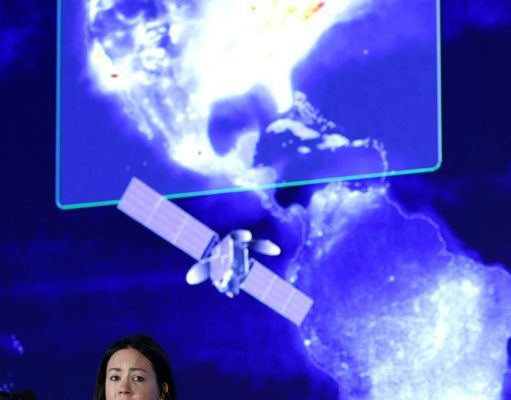Physicist Caroline Nowlan gives a press conference in Washington on March 14, 2023 on NASA’s “TEMPO” instrument, which will measure air pollution in North America (GETTY IMAGES/AFP/ALEX WONG)
A satellite took off overnight Thursday to Friday from Florida, carrying a new NASA instrument that will measure hour by hour, neighborhood by neighborhood, air pollution over America North.
This scientific tool, called TEMPO, should make it possible to follow the diffusion of pollutants much more precisely than hitherto, from their emitting source and throughout their propagation by the wind.
The data collected will be used in particular by the US Environmental Protection Agency (EPA) and the US National Oceanic and Atmospheric Agency (NOAA), in charge of air quality forecasts in the United States.
The applications are multiple: improving alerts to inhabitants in the event of poor air quality, better determining the places where new detectors must be installed on the ground, or even helping research on the impact of atmospheric pollutants on health.
But also follow the pollution caused by fires, which are more and more frequent due to global warming.
About 40% of Americans (137 million people) live in areas with poor air quality, according to the American Lung Association. The poorest neighborhoods are disproportionately affected.
Air pollution thus causes approximately 60,000 premature deaths per year in the United States. It is also bad for the economy, with an impact on the productivity of workers, or even on crops.
– “Every hour” –
The satellites used so far to make this type of survey in the United States are located at an altitude of about 700 km and circle the Earth about fifteen times a day.
“So every day, we can have measurements over New York at 1:30 p.m., for example,” Caroline Nowlan, an atmospheric physicist at the Center for Astrophysics, explained at a press conference. But “there’s a lot going on in New York in a day. There’s two peak hours that you can’t measure.”

NASA’s Laura Judd in front of a visualization of the area covered by the TEMPO instrument during a press conference on March 14, 2023 in Washington (GETTY IMAGES/AFP/ALEX WONG)
TEMPO, which weighs just under 140 kg, will be attached to a satellite in geostationary orbit, at an altitude of more than 35,000 km. It will therefore revolve around the Earth at the same time as the latter revolves on itself, allowing it to always be above the North American continent.
“For the first time, we will be able to take hourly measurements over North America,” said Caroline Nowlan.
Geostationary orbit is very common for telecommunications satellites, and it is on one of them that TEMPO was grafted: the Intelsat IS-40e satellite.
– Ozone and nitrogen dioxide –
The satellite lifted off Friday at 12:30 a.m. (4:30 a.m. GMT) aboard a SpaceX Falcon 9 rocket from Kennedy Space Center in Florida. It will operate additional thrusts itself to get into the right orbit, which should take about two weeks, according to Jean-Luc Froeliger, vice president at Intelsat.
Then operations can begin.
TEMPO will work by analyzing the light reflected off the surface of clouds, using a spectrometer. Each gas absorbs light differently, so “we can see what’s in the atmosphere via the colors, or wavelengths, of light that are absorbed,” Caroline Nowlan explained.
Three main actions will take place.
First, the nitrogen dioxide produced by combustion, in particular by petrol or diesel cars, but also coal or gas-fired power stations.
Then ozone, which when it is high in the atmosphere protects us from the sun’s rays, but becomes harmful to health when it is on the ground.
Finally, formaldehyde, which can be used to infer the presence of volatile organic compounds. These are “what makes certain things smell, like paint, gasoline or markers,” says Ms Nowlan.
TEMPO, which will operate for at least two years but most likely much longer, joins NASA’s fleet of about 25 Earth observation missions.
A tool similar to TEMPO, called GEMS, is already in geostationary orbit to fulfill the same mission over Asia, since its takeoff in 2020.
And another, Sentinel-4, is planned from 2024 to cover Europe.
© 2023 AFP
Did you like this article ? Share it with your friends with the buttons below.




